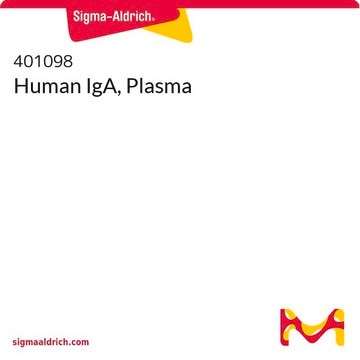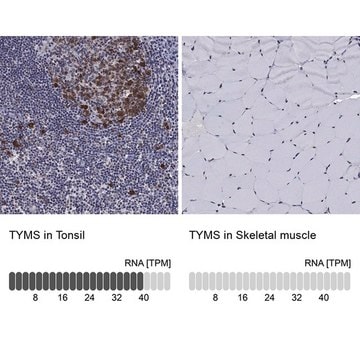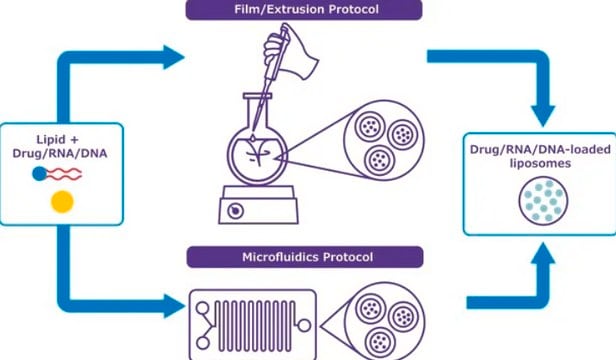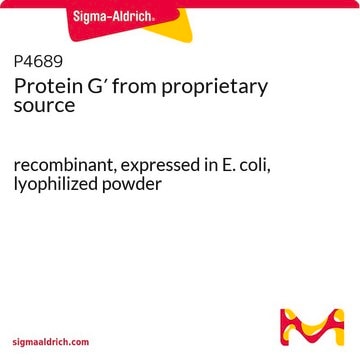MAB4130
Anti-Thymidylate Synthase Antibody, clone TS106
clone TS106, Chemicon®, from mouse
Synonim(y):
Thymidylate synthase
About This Item
Polecane produkty
pochodzenie biologiczne
mouse
Poziom jakości
forma przeciwciała
purified immunoglobulin
klon
TS106, monoclonal
reaktywność gatunkowa
human, mouse
reaktywność gatunkowa (przewidywana na podstawie homologii)
rat
producent / nazwa handlowa
Chemicon®
metody
ELISA: suitable
flow cytometry: suitable
immunofluorescence: suitable
immunohistochemistry (formalin-fixed, paraffin-embedded sections): suitable
immunoprecipitation (IP): suitable
western blot: suitable
izotyp
IgG1
numer dostępu NCBI
numer dostępu UniProt
Warunki transportu
wet ice
docelowa modyfikacja potranslacyjna
unmodified
Opis ogólny
Specyficzność
Immunogen
Zastosowanie
A previous lot of this antibody was used in ELISA.
Flow Cytometry:
A previous lot of this antibody was used in FC.
Immunofluorescence:
A previous lot of this antibody was used in IF.
Immunoprecipitation:
A 10 μL/mg concentration of a previous lot was used on protein lysate.
Immunohistochemistry (Frozen and Paraffin sections):
1:50 - 1:100 (with incubation for 30-60 minutes at room temperature). TS106 can benefit from antigen retrieval with either EDTA pH 8.0 or 10mM citrate buffer pH 6.0 .
Western Blotting:
1:200 - 1:400. Recognizes a 36KDa band.
Optimal working dilutions must be determined by end user.
Epigenetics & Nuclear Function
Cell Cycle, DNA Replication & Repair
Jakość
Western Blot Analysis:
1:500 dilution of this antibody detected THYMIDYLATE SYNTHASE on 10 μg of MCF7 lysates.
Opis wartości docelowych
Postać fizyczna
Przechowywanie i stabilność
Komentarz do analizy
Positive Control: 5-FU-resistant colon carcinoma cell lines (NCI H630R10, NCI630R1), 5-FU-resistant breast cancer cell lines, MCF-Ad5 and MCF-Ad10
Inne uwagi
Informacje prawne
Oświadczenie o zrzeczeniu się odpowiedzialności
Kod klasy składowania
10 - Combustible liquids
Klasa zagrożenia wodnego (WGK)
WGK 2
Temperatura zapłonu (°F)
Not applicable
Temperatura zapłonu (°C)
Not applicable
Certyfikaty analizy (CoA)
Poszukaj Certyfikaty analizy (CoA), wpisując numer partii/serii produktów. Numery serii i partii można znaleźć na etykiecie produktu po słowach „seria” lub „partia”.
Masz już ten produkt?
Dokumenty związane z niedawno zakupionymi produktami zostały zamieszczone w Bibliotece dokumentów.
Nasz zespół naukowców ma doświadczenie we wszystkich obszarach badań, w tym w naukach przyrodniczych, materiałoznawstwie, syntezie chemicznej, chromatografii, analityce i wielu innych dziedzinach.
Skontaktuj się z zespołem ds. pomocy technicznej








